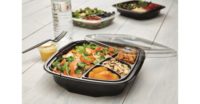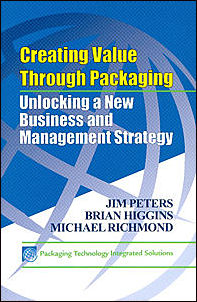The Freshness Dilemma

The Freshness Dilemma
By Ken Miller and Jim Warner
Conveying “fresh” in packaging so consumers will pay for it.
Consumers are more concerned with freshness in the food they buy these days. Several indicators suggest that this is not just fashion, but is intimately linked to lifestyle issues and values—making it clear that the focus on freshness is here to stay.
Circumstantial evidence is as follows: Consumers are shopping much more frequently, and spending much more time in the perimeter of the store, where fresh items rule. While this could also be attributed to factors such as convenience, the result is that consumers purchase fresher foods because the frequency of their shopping trips permits it. That’s aside from the inherent positive attributes of fresh food—appearance and aroma—that attract them.
We can also point to the growth in the local green market phenomenon. Consumers believe locally grown food is fresher than that typically found in supermarkets. While this may or may not be the case, it does suggest how consumers define “fresh” and how they value it.
And let’s not forget the recent emphasis fast food outlets have placed on delivering fresher options. While such offerings might confuse healthiness with freshness, they indicate that the issue has permeated the mass culture and value system to the extent that purveyors who might prefer to sell mega-sized bacon cheeseburgers have taken notice.
Even “white goods” manufacturers are keen on fresh. Have you looked inside the latest crop of refrigerators? Companies like GE have recognized the move toward freshness, and are incorporating visible functionality to maintain it. Interior features (and their catchy names) include dedicated controls, stacks and bins that store, maintain, chill and thaw your precious meat and produce to push the boundaries of freshness and convenience.
The focus on freshness is clear, but, because there are no nationwide standards, the manner in which manufacturers communicate “fresh” is all over the place. In some categories, freshness dating (“best when used by”) is attended to, but somewhat confusing. Sure, it can be useful, but many manufacturers see it as a two-edged sword because they can’t control how long their product may sit on the store shelf. Plus, unlike other packaging communication, it’s not usually presented in a way that makes a graphic impact.
Many consumers believe that locally grown and packaged foods are fresh because they get to market quicker. Green markets operate under this halo. And the growth of organic offerings lends further clutter to what defines “fresh”.
So, without a definitive benchmark or definition but only a strong conviction that “freshness” is important, what are consumers to do? Well, they can look for signals.
An Ipsos study in 2005 indicated that consumers believe taste and freshness (and the cues that impart them) are the most important attributes in the food they buy. However, about half said they would not pay more for added freshness; and when asked how much more they might pay for a $3 item with packaging that ensures freshness, two-thirds of respondents said 10 cents or nothing. Why this contradiction? Is it because products are fresh enough?
We think not. We think it’s because the technology and “innovation” used to deliver freshness does not have impact with consumers. It’s not convincing. Sometimes, it’s not even apparent. Such packaging innovations hardly ever suggest in a conspicuous and intuitive fashion that one product is fresher than the other. So, without the tools to imagine packaging could really ensure freshness, consumers, quite naturally, say that they would not pay for it.
Of course, packaging companies are making great strides in delivering freshness in store-bought packaged goods. Permeable “smart” films, for instance, maintain freshness in bagged salads. But who can tell? Gases scavenge for oxygen in packaged fruit. But can I see it happening? Processing technologies such as aseptic packaging keep food at its peak. But does an aseptic package really look like the embodiment of freshness? Remember the challenge Parmalat milk had when it launched in the United States? Because American consumers associate fresh milk with a cold product, they were resistant to the idea of milk in this shelf-stable (ambient temperature) package. Get the point?
“Show me what freshness looks like, and I might pay for it,” consumers are saying.
They need a reason to believe. Consumers need packaging with attributes that convey freshness in the store. They need multi-sensory cues. How about a thoughtful use of materials that not only does the job, but looks like it does the job. And new features that drive the perception as well as the functional delivery of freshness.
What products do a good job of this today? Not many, but here are a few attempts:
Eight O’ Clock Coffee bags show a small button that is integrated into a “freshness guaranteed” banner on the front of the package. Small print on the back identifies a “unique freshness valve”. Not a bad idea, until you read further down the panel: “To preserve freshness, close bag securely or transfer to an airtight container,” it says. So, what does this thing do? And given its rather mysterious presence and claim, how would I know?
In contrast, McCormick does a very nice job suggesting freshness with its grinder line of seasonings. We all know how long those spice jars hang around in kitchen cabinets. As they multiply in there, it becomes more difficult for them to replicate the flavors of fresh herbs and spices. Perhaps that’s why McCormick included a grinding mechanism in the packaging. The product grains are in their natural state, seemingly unprocessed until the moment they are needed—during the cooking and consuming occasion. Nothing says “peak of freshness” like a product that can be “whipped up” just when consumers need it. Now, packaged seasonings can truly substitute for fresh.
Baker’s Inn bread packaging does a nice job of keying on freshness cues. A snug craft paper sack is sealed with paper tape. The sack is thin enough to allow consumers to squeeze the package and feel exactly how fresh the product is. A large window shows off the nicely textured, un-sliced multi-grain loaf. And a re-closable inner bag keeps it in peak form at home. This package fires on all cylinders to communicate and deliver “fresh”.
4C Grated Cheese went back to basics to say its product is freshest. While the competition was going to plastic and fiber-wound cylinders to cut costs, 4C went to glass. Theirs is a nice looking bottle with heavy gripping texture and a heftiness that says this is a premium product. Of course, glass always says “fresh”, and is thought by most consumers to preserve taste better. We bet the table-worthy look doesn’t hurt use-up rates either.
So how do you build freshness cues into your own package structures in a way that will be meaningful and compelling to consumers? With the above examples in mind, we offer the following principles for consideration:
1. Transform for taste
Think about ways that allow the consumer to release the best attributes of your product exactly when they want them. Perhaps the product is transformed in some way (note McCormick’s grinder packaging) or mixed with other ingredients. Or separated as a fresh serving from a bulk portion. Giving the consumer control over when and how the product is transformed strongly implies freshness, particularly when the product can be presented in its natural (more or less) state before its taste is released.
2. Freshness in form and function
Consider ways to make freshness more conspicuous on shelf and in-use with a package feature that is intuitive and believable. Distinguish between features that might preserve the product until the moment it’s purchased, and those that might keep the product fresh once opened at home. These are two different promises, and deserve to be championed with distinct functionality. Innovative valves, closures and substrates need to do more than just work—they need to look like they work. They might demand interaction with the consumer. And jump off the shelf with visual, purposeful distinction.
3. Making sense of freshness
Consumers test for freshness with their senses. Feed them. Invite consumers to feel the product. Use materials that squeeze in and allow consumers to experience the texture and give in the product. Permeability might allow aroma to escape. It probably goes without saying, but give the consumer a good look in. Visible color, form and texture count. Proper use of the senses allows the consumer to truly experience the product in the aisle in a completely valid, persuasive and genuine way. Graphics that scream “bakery fresh” just aren’t as convincing.
No doubt there are infinite ways to bring freshness to life for consumers when they’re ready to buy. The point is that they won’t pay for it unless they can see it in action. And they simply can’t see most new technologies in action. So the next time your research says consumers value freshness, show them some really fresh thinking.
FRESH OFF THE BLOCK
Consumers identify block cheese with natural freshness, preferring to slice it themselves at the right moment. How about package functionality that brings freshness imagery to life with each slice?
A plastic blade is housed within an injection molded tray and covered with a thermoformed lid. Slide the lid (with cheese inside) across the tray, and adorn that sandwich or cracker with a just-cut slice!
A plastic blade is housed within an injection molded tray and covered with a thermoformed lid. Slide the lid (with cheese inside) across the tray, and adorn that sandwich or cracker with a just-cut slice!
Pumped Up Freshness
This package idea takes the “freshness valve” to new heights. As a concept, the consumer interacts with the package daily to exchange fresh air. The “pumped up” on-shelf appearance drives home the benefit, along with an intuitively functional valve. Consumer involvement in-store and in-home creates a harder hitting message that truly delivers.
Jim Warner and Ken Miller are managing directors at laga | one80 design, the product and package innovation and design unit of laga. Jim lends creative concept development and implementation for client programs. Ken focuses on research methodology and marketing strategy to provide focused design direction for creative teams. Contact them at 212.268.1801 or visit www.one80design.com
Looking for a reprint of this article?
From high-res PDFs to custom plaques, order your copy today!







